
According to research done by the charity Made By Dyslexia, 71% of people with dyslexia are above-average communicators. They excel at finding clear and engaging ways to convey ideas.
Yet, despite that statistic, many dyslexic writers struggle when it comes to putting those ideas down on paper due to grammar, spelling, and writing style mistakes. At ProWritingAid, we believe that the technicalities of writing shouldn’t be a barrier to communicating exceptional ideas.
Dyslexic Writers in the ProWritingAid Community
We’ve had several writers from our community reach out and tell us that, because they are dyslexic, one of the reasons they love the software is that it helps them to feel confident in their writing.
Building on these conversations, we wanted to share information, stories, and resources to help empower dyslexic writers to share their ideas with the world.
”I’m a massive fan of ProWritingAid. Being dyslexic, I need the best spelling and grammar checker, and I think some of its suggestions and sentence placements have made me a better writer.” —Steven on Twitter
”Suffering from severe dyslexia is bad enough, but this software now helps me to produce better work with fewer mistakes.” —Colin on Facebook
In this article, we share five key ways that writing technology can help dyslexic writers, with stories from ProWritingAid users. You’ll find helpful resources in each section—check them out to see which suit your writing process best.
1. Fix Spelling Mistakes
Most of us make spelling mistakes while writing. You might:
- Spell a word phonetically
- Mix visually similar letters, like d/b or p/q
- Miss out a word
- Swap letters in words
The spell-checkers you get with your writing software are getting more advanced, and can help catch more than just spelling errors. The kinds of mistakes above can usually be solved with a click. However, there are some things that these spell-checkers won’t pick up on.
Readers will notice missing prepositions, but your spell-checker may not highlight them.
Take this sentence:
I need to go to the supermarket today.
Because the word to features twice, it’s easy to skip over the second instance when typing, leaving us with:
I need to go the supermarket today.
When I ran this through MS Word, there wasn’t a squiggly line in sight. Google Docs caught the missing to and suggested adding it in. However, it didn’t tell me why the suggestion was being made.
ProWritingAid will pick up on missing prepositions, and let you know why the correction has been suggested.
In the screenshot below, you can see the highlight and the message telling you that there’s a “possible missing preposition.”
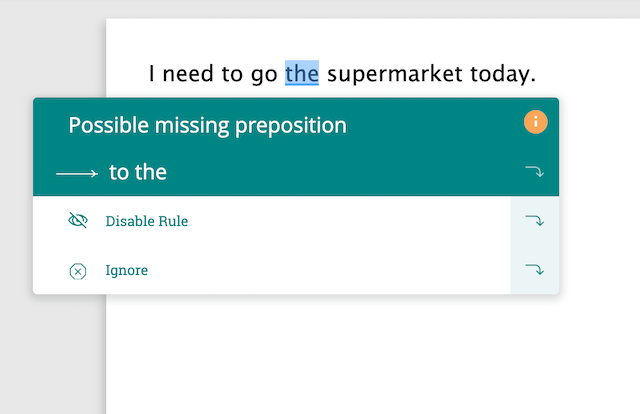
While you might not need a full explanation for this mistake, seeing that prompt will encourage you to keep prepositions in mind as you write and proofread.
If you’d like a reminder of what a preposition is and how to use them, you can click the orange “i” icon for more information.
One of our users, Michelle Monarrez, said:
“I can run my writing through the regular spell checkers, but these don’t catch all my typos and tense mistakes. This makes my editing process a lot longer and a process I dread. ProWritingAid to the rescue! I use it every time I’m writing anything, even just emails for my day job that aren’t related to my writing career.”
2. Correct Misused Homonyms (that Word Won’t Catch)
Sometimes, the correction offered by your spell checker isn’t actually what you’re trying to say or spell.
You might have typed their instead of there, or witch instead of which. Because these words are spelled correctly, your spell-checker won’t flag it.
Picking these mistakes out of your own writing is difficult. You know what you meant to type, so you’re more likely to miss them.
Here’s what it looks like:
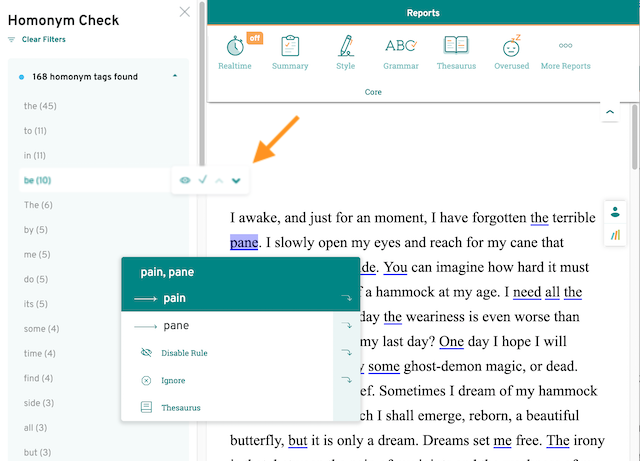
When you hover over a highlight, you’ll see all of the different spellings you could use.
You can tailor the report using the navigation menu that appears when you hover over the words to the left of the screen.
This report may be more useful for some than others—it completely depends on how you work.
If you’re familiar with the word you meant to use, the homonym report lets you find incorrect spellings and change them with a click. But if you’re not sure which is the right spelling for your context, this can mean looking up definitions for each.
Seeing so many words highlighted at once can be overwhelming. If this doesn’t look helpful for you, you can skip over the report.
For common mistakes like confusing their/they’re/there and your/you’re, ProWritingAid’s realtime report will usually suggest the correct spelling for your context, like this:
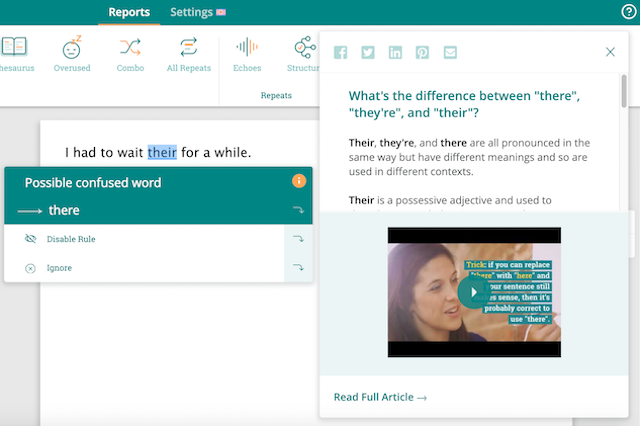
In these cases, you can just click to insert the correct suggestion.
If you want to check more unusual words, or words that our AI hasn’t seen writers confuse very often, though, the Homonym Report is the best way to go.
You don’t need to run through all of the highlights: the navigation menu helps you tailor the report to you.
Here’s an example of how that might work:
The only homonym for be is bee. I know I didn’t mean to write bee anywhere in my document, so I don’t need to see these. I can hide the highlights for be by hovering over it in the list and clicking the eye icon that appears. This allows you to narrow the highlights down to the words you actually want to double-check.
Try out the Homonym Report to see if it works for you with a free ProWritingAid account.
3. Create an Outline
Dyslexia can make planning and ordering your writing difficult. Getting your thoughts down on paper can be hard enough without making sure they’re in the right order as you do it.
ProWritingAid user Marios Eracleous found that:
“When it came to academic work, I would find it difficult to make notes and put my thoughts down on paper. When I did, they would sometimes be jumbled up and the middle and the end were mixed up.”
The final order of the points in your essay or the scenes in your chapter is down to you to decide. However, transition words can help you sign-post your structure and make it easier to follow for both you and your reader.
Adding transitions like firstly, secondly, thirdly, therefore, or on the other hand helps to mark when you’re changing direction or linking ideas together.
Once you have your ideas down on the page (even if they’re not in the right order), try writing out some transition words and then filling in the blanks with your points, like this:
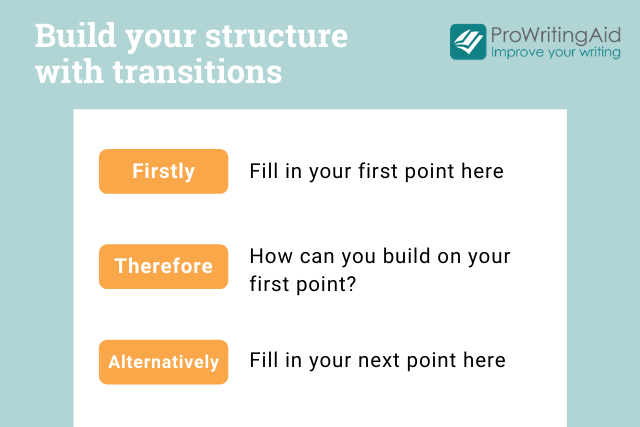
Even if you don’t use those words in the end, using this method to visualise the different stages of your argument or story can help you start to put your ideas in the right place.
If you’ve already written a document, you can use ProWritingAid’s Transitions Report to highlight all of the transitions in your writing. This allows you to jump to each transition word you’ve used to check your points are in the right order.
Or, if the report tells you you don’t have enough transitions, can prompt you to reconsider whether your reader will be able to follow your work.
If you’re a fiction writer, check out these alternative methods for outlining your novel that use different areas of your brain. It’s a good idea to try a few methods to see what you connect with best.
4. Keep All Your Grammar Lessons in One Place
There are a lot of grammar rules out there, and it’s impossible to keep track of them all. With ProWritingAid, you don’t have to.
Remember those red pen marks on your schoolwork that often came with no explanation? You won’t find those in our editing tool.
Here’s what a ProWritingAid suggestion looks like:
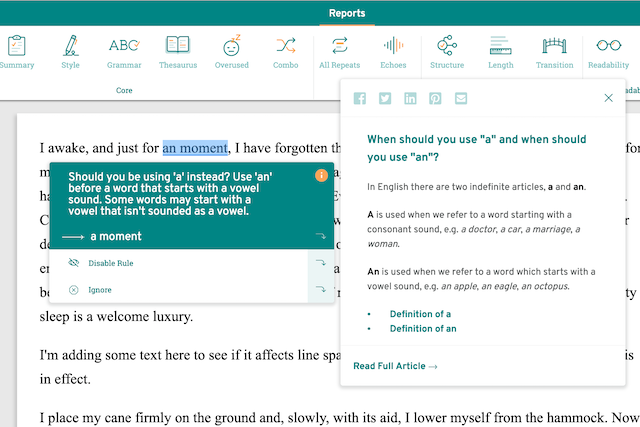
Each suggestion has a button to click for more information. We know that people process information in different ways, so you can read an article about a particular grammar rule, or watch a video to learn more.
Good grammar isn’t the be all and end all of good writing. Brilliant writers break grammar rules all the time.
The extra information in ProWritingAid’s suggestions helps you feel confident that you’re breaking a rule intentionally. If you have made a mistake, you can easily find out why.
5. Avoid Overusing Words
It makes sense to use words that you’re confident in spelling over more unfamiliar words when you’re writing your first draft.
If you have to keep stopping to check the dictionary, you’ll lose what matters most: your flow of ideas.
But once you’ve finished writing, it can be difficult to spot where you’ve used these words repeatedly because they are so familiar.
ProWritingAid’s Repeats Check will highlight words you’ve used repeatedly in your document as a whole. The Echoes Check will highlight words you’ve used several times close together.
Think of these reports as a fresh pair of eyes looking over your work. They’ll tell you if a word has been used enough to become distracting, and then give you several alternatives to choose from.
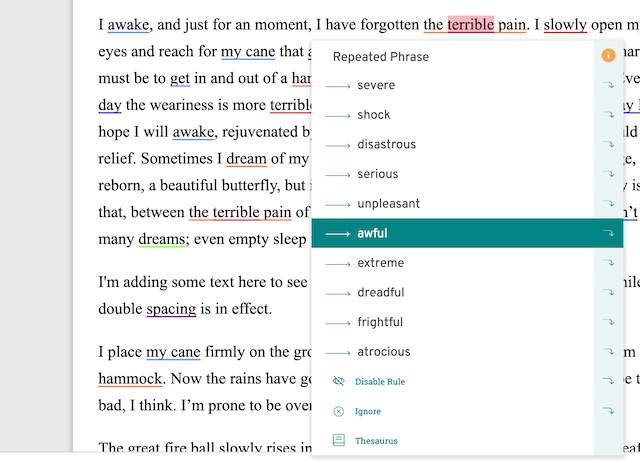
Unlike the synonyms features in Word or Google, our AI will provide suggestions that fit the context of your writing.
That said, you don’t need to change every single word. Sometimes familiar or simpler words are the ones that get your meaning across most effectively.
Rather than focussing on just individual suggestions, author K.A. Ashcomb takes a more holistic approach:
“The answer to me is not to abuse the built-in Thesaurus, but to think about what the suggestions mean for my writing as a whole.”
Click here to read more about her writing process with ProWritingAid.
More Useful Resources
If you’re looking for more resources on grammar rules and writing techniques that don’t feel like you’re back at school, check out the following resources:
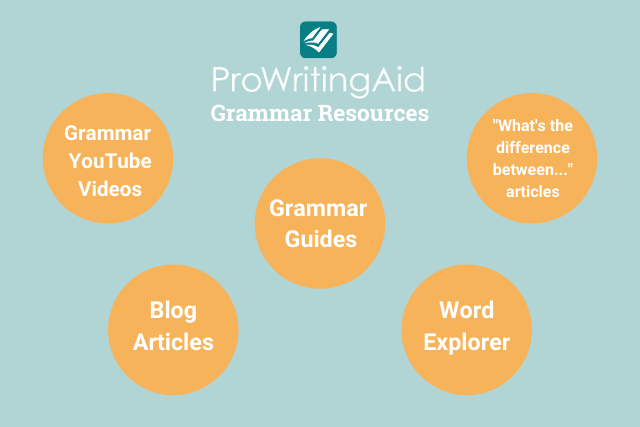
We’ll go into more detail below, but here are some quick links to find out more:
- Grammar guides: Wondering how to use a comma or what bad adverbs are? Here are our simple guides.
- Blog articles: We offer clear explanations for some of the more difficult grammatical topics
- Word explorer: learn more about the words you use with definitions, common uses, rhymes, and quotes
- Video guides: Perfect for visual learners
- “What is the difference between…” articles: Wondering what the difference is between adverse and averse? Find out here.
Grammar guides
Our AI is smart, but sometimes it can’t understand the context of your sentence.
There are some rules, like the difference between affect and effect and when to use which or that, that require more intervention from you as a writer.
The links in that sentence will take you to some of our grammar guides. Bookmark the rules you struggle with most often for easy access while you’re writing!
Blog articles
Grammar rules can feel like a barrier. If you’re interested in learning more about how they can become tools for you as a writer instead, check out some of the fun articles on our blog like this grammar cheat-sheet to keep handy while you’re writing.
Word explorer
We want to make grammar accessible for as many people as possible. ProWritingAid user Georgi Neydenov said:
“The built-in word explorer [has] greatly assisted me in reaffirming concepts I had issues learning during my high school years.”
If you have any suggestions for other helpful guides, let us know at hello@prowritingaid.com.
Video guides
If you prefer to learn by watching videos, you’ll find loads of helpful guides over on our Youtube channel.
Here’s our video on when to use than or then:
What is the difference between assent and ascent?
As well as our editing tool, we’re constantly working to provide content on all of the grammar questions you could possibly think of.
Our “What is the difference between…” articles can help you work out if the word you have written is spelled incorrectly, or if you’ve used a homonym. If you are using the homonym report, a quick search here can help you work out which suggestion is right for your context.
We’ve tried to cover as many differences as possible so that you can feel confident that you’ve used the right word for your purpose.
We want to help more dyslexic writers
These are just five ProWritingAid resources we think you might find useful while writing. If you’d like to find out more about how ProWritingAid can help, this article covers six of author Krystal Craiker’s favorite ProWritingAid reports.
Do you already use ProWritingAid? Have we missed any useful features off of this list, or is there anything you’d like to see? Let us know in the comments!

